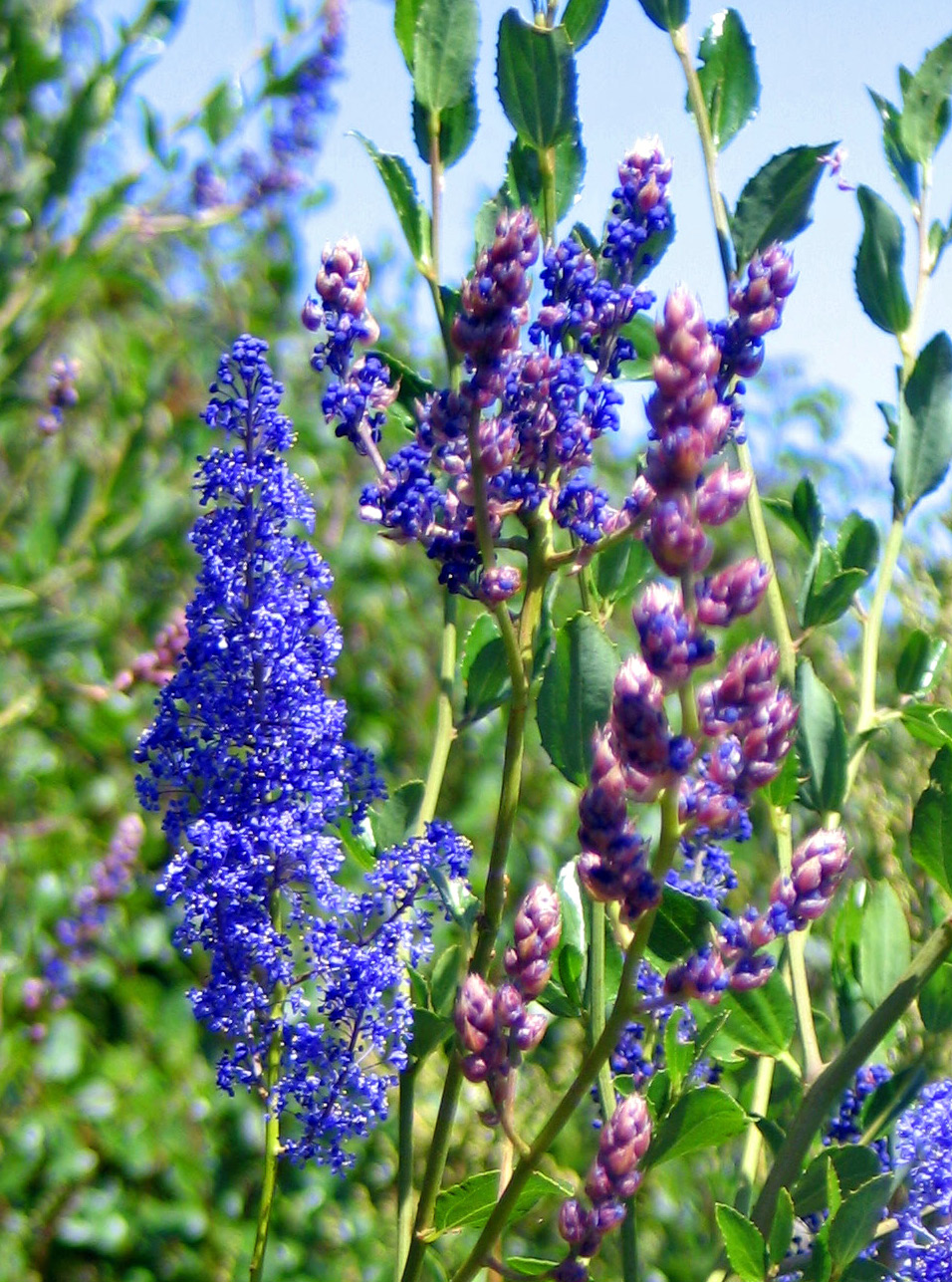
Lakeside Ceanothus
Ceanothus cyaneus
Ceanothus cyaneus
Photo Credit: Patricia Gordon-Reedy
|
Valley Fire Rare Plant Discovery Surveys
A project between the SDMMP and US Forest Service to establish and prioritize survey areas on Conserved Lands within the perimeter of the 2020 Valley Fire to document whether historic occurrences are extant and to discover new occurrences for 18 rare plant species. In 2022, AECOM and Conservation Biology Institute botanists surveyed areas for 18 target rare plant species and mapped the spatial extent of each new occurrence, counted or estimated the occurrence population size, and collected voucher specimens. They also photographed each new occurrence from a georeferenced location that captured a representative view of the occurrence. Botanists created a species list for the areas surveyed within the Valley Fire footprint. These areas included locations where rare plants were detected and mapped and negative data point areas where rare plants were not detected. In 2023, botanists shall again conduct surveys on suitable habitat on USFS lands burned in the 2020 Valley Fire. Results from these surveys should lead to a greater understanding of post-fire rare plant composition. In 2023, botanists may see species that did not emerge in the first year of surveys, and species found in the first year of surveys may have expanded their range. The 18 rare plant species included in the surveys are: San Diego thornmint (Acanthomintha ilicifolia), Marvin's allium (Allium marvinii), Western spleenwort (Asplenium vespertinum), Deane's milkvetch (Astragalus deanei), Encinitas baccharis (Baccharis vanessae), San Diego goldenstar (Bloomeria clevelandii), Orcutt's brodiaea (Brodiaea orcuttii), Lakeside ceanothus (Ceanothus cyaneus), San Miguel savory (Clinopodium chandleri), Variegated dudleya (Dudleya variegata), Mission Canyon bluecup (Githopsis diffusa filicaulis), Ramona horkelia (Horkelia truncata), Heart-leaved pitcher sage (Lepechinia cardiophylla), Felt-leaved pitcher sage (Monardella hypoleuca lanata), Chaparral nolina (Nolina cismontana), Gander's ragwort (Packera ganderi), Moreno currant (Ribes canthariforme), and Parry's tetracoccus (Tetracoccus dioicus).
|
| File name | Lead Author | Year | Type |
|---|---|---|---|
| 2012 Biological Monitoring Status Report Crestridge Ecological Reserve and South Crest Properties | Conservation Biology Institute | 2012 | report |
| Biological Monitoring Status Report for Crestridge Ecological Reserve and South Crest Properties | 2012 | report | |
| County of San Diego MSCP Monitoring Summary Report January 1998 - June 2007 | County of San Diego | 2007 | report |
| Habitat Management and Monitoring Plan for the Crestridge Ecological Reserve- 2002 | 2002 | report | |
| Habitat Management and Monitoring Plan for the Crestridge Ecological Reserve- 2009 | 2009 | report |
Peninsular Ranges [1] in Riverside and San Diego County [2]. Northern Baja California, Mexico.
Seven occurrences on Conserved Lands in MUs 3 ( Crestridge Ecological Reserve, Gibson Highlands, Kemerko) and 4 (Boulder Oaks Preserve, El Capitan Open Space Preserve, Oak Oasis Preserve, Louis A. Stelzer County Park).
None [2].
Dry, shrubby slopes [1]. Chaparral [2]. Often found in dense chaparral with a mix of chamise and species of manzanita [4]. May be restricted to acid igneous rock and Cieneba soils [8]. Elevation range 45-1050 meters [3].
Ericaceae family [2]. Rhamnaceae family [2]. Subject to hybridization with other Ceanothus species [4].
Perennial evergreen shrub [2].
Bloom period April-June [2].
Regenerates by seed only after fire [6]. Depends on sufficient soil seed bank for survival. Honey bees (Apis melifera), bumble bees (Bombus sp.), carpenter bees (Xylocopa sp.), yellow-faced bees (Colletidae family), sweat bees (Halictidae family), bee flies (Bombyliidae family), and flower flies (Syrphidae family) are all confirmed pollinators [7].
Development [2] and increased fire frequency [6]. Invasive species, grasses in particular, are a potential threat. Nonnative plants can outcompete native plants that attract bees and pollinating flies to the area of C. cyaneus[7].
Ceanothus stem-gall moth (Periploca ceanothiella) has been documented, but is not a known threat [5]. Subject to hybridization with other species of ceanothus [4]. The Conservation Biology Institute (CBI), Institute for Conservation Research, and the Santa Ana Botanic Garden have all participated in management programs focused on seed bank work [6]. Seed collection and restoration can augment the population to ensure that genetic diversity is not lost as a result of a fire or other catastrophic event [10]. In 2010, CBI set up permanent photopoint monitoring at Crestridge Ecological Reserve as a supplement to annual species monitoring as an "early warning" system [9]. Prescribed fire could be used to promote a diverse age structure to ensure reproduction and persistence [10].
[1]  Hardig, T. M., P.S. Soltis, and D.E. Soltis (2000). Diversification of the North American Shrub Genus Ceanothus (Rhamnaceae): Conflicting Phylogenies From Nuclear Ribosomal DNA and Chloroplast DNA. American Journal of Botany, 87(1), 108–123.
[2] CNPS, Rare Plant Program. 2016. Inventory of Rare and Endangered Plants (online edition, v8-02). California Native Plant Society, Sacramento, CA. http://www.rareplants.cnps.org accessed 07 September 2016.
[3] Wilken D. H. 2016. Ceanothus cyaneus, in Jepson Flora Project (eds.) Jepson eFlora, http://ucjeps.berkeley.edu/cgi-bin/get_IJM.pl?tid=18438, accessed on September 07, 2016.
[4] Reiser, C. H. (2001). Rare Plants of San Diego County. San Diego, CA: Aquifer Press.
[5] Munro, A. J. (1963). Biology of the Ceanothus Stem Galling Moth Periploca Ceanothiella. Journal of Research on Lepidoptera, 1(3), 183–190.
[6] Gordon-Reedy, P. 2012. “Biological Monitoring and Management Crestridge Ecological Reserve (and South Crest Properties).â€
[7] Klein, M.W. 2009. “Pollinator Study on Lakeside Ceanothus (Ceanothus Cyaneus) and San Diego Thornmint (Acanthomintha Ilicifolia).†Contract No. PO650018. Sacramento, CA.
[8] U.S. Department of Agriculture- Soil Conservation Service. 1973. “Soil Surveys: San Diego, California. Parts I and II + Maps.â€
[9] Conservation Biology Institute. 2012. “2012 Biological Monitoring Status Report Crestridge Ecological Reserve and South Crest Properties.†San Diego, CA.
[10] Conservation Biology Institute, and Endangered Habitats Conservancy. 2009. “Habitat Management and Monitoring for the Crestridge Ecological Reserve.†San Diego, CA.